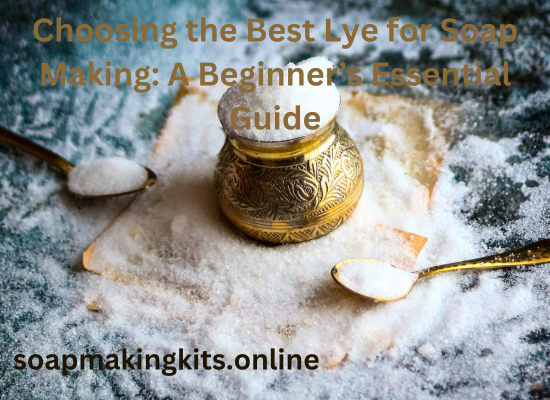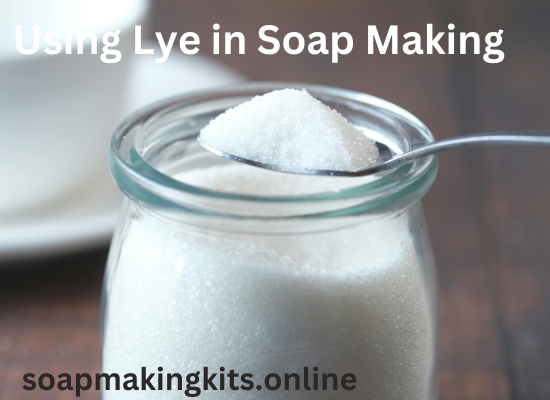Selecting the right lye is essential for successful soap making—whether you’re creating a bar or liquid soap, quality and safety matter. Sodium hydroxide (NaOH) is ideal for solid bars, while potassium hydroxide (KOH) is best for liquid soaps, each affecting texture and lather. With proper handling and accurate measurements, you can craft high-quality, skin-friendly soaps with ease and confidence!
Soap making is a magical mix of creativity and chemistry—where art meets science to create something both functional and luxurious. At the heart of this craft lies Lye, the unsung hero who transforms oils into silky, skin-loving soap. But with so much information out there, how do you pick the right lye for your project? Let’s simplify the process and give you the confidence to start crafting!

What is Lye, and Why Can’t You Make Soap Without It?
Lye (sodium hydroxide or potassium hydroxide) is a strong alkaline substance that triggers saponification—the chemical reaction where oils and fats become soap. No lye, no soap. It’s that simple! The type and quality of lye you choose directly impact your soap’s texture, lather, and longevity.
Types of Lye: Which One Should You Use?
Not all lye is created equal. Here’s the lowdown:
Sodium Hydroxide (NaOH)
Best for: Classic bar soaps.
Why? It creates hard, long-lasting bars with a rich lather.
Pro Tip: Opt for 100% pure, food-grade NaOH. Avoid brands with fillers or additives—they’ll sabotage your soap!
Potassium Hydroxide (KOH)
Best for: Liquid or cream soaps (like hand soap or shaving cream).
Why? It produces a softer, water-soluble soap.
Pro Tip: For Beginners, stick with NaOH first. KOH It requires different factors eg making soap with a hot process method
Read more: Easy way to make aloe vera soap: and its best benefits
How to Choose the Right Lye
Your lye choice hinges on two things:
Your Soap Goals
Bars = NaOH | Liquids = KOH
Lye Quality
Only use USP/food-grade lye. Hardware store varieties often contain impurities (like rust inhibitors) that ruin saponification.
Lye Safety: Non-Negotiable Rules
Lye is caustic—it can burn skin or damage surfaces. But fear not! Follow these rules to stay safe:
Gear Up: Gloves, goggles, and long sleeves are mandatory. No exceptions!
Ventilation Matters: Mix lye near an open window or under a vent. Those fumes are nasty!
Mix Smart: Always add lye to water (never water to lye!) to avoid dangerous eruptions.
Store Safely: Keep lye in an airtight container, labeled clearly, and far from kids/pets.
Read more: Recipe to make glycerin soap easily at home
Step-by-Step: Using Lye in Soap Making

Calculate Precisely: Use a soap calculator (like SoapCalc) to nail your lye-to-oils ratio. Even a small error can ruin a batch!
Prep Your Space: Lay out molds, oils, tools, and safety gear first. Once lye’s mixed, there’s no time to scramble.
Mix Lye Solution: Slowly stir NaOH into cool distilled water. It’ll heat up fast—let it cool to 100–130°F before mixing with oils.
Combine & Blend: Pour the lye solution into warmed oils. Continue to use the Upstack Blender until you know whether it has reached a future state like Custard or not.
Mold & Cure: Pour into molds, insulate for 24 hours, then unmold. Cure bars for 4–6 weeks for a harder, milder soap.
Read more: Homemade tea tree oil cleanser soap recipe for natural skin clean
Common Lye Mistakes (and How to Avoid Them)
Using Cheap Lye: Impure lye = crumbly, oily, or irritating soap. Spend a few extra cents for quality.
Eyeballing Measurements: Guessing causes lye-heavy or oily soap. Use a digital scale!
Skipping the Cure: Patience is key! Uncured soap is harsh and won’t last.
Packing and storage lye
Lye is a caustic substance and can be hazardous if not stored properly. When buying lye, pay attention to the handling instructions. Most of them come in plastic containers, while others can be stored in paper bags. lye safety guide Proper drying is essential to prevent moisture absorption and may cause unexpected reactions. Always store Lye in a cool, dry place away from children, pets, and eaters.
See More: Know where to find the best soap-making store and supplies
Conclusion
Choosing the right lye is like picking the perfect paint for a masterpiece—it lays the foundation for your soap’s success. Start with sodium hydroxide for bar soap, prioritize purity and safety, and don’t rush the cure. Before you know it, you’ll be crafting bars that rival boutique brands!
Have a lye-related question or a soap-making win to share? Drop a comment below—let’s chat!
This revised guide adds a conversational tone, practical tips, and relatable examples to create a more engaging, human-centric feel. If you have any queries you can contact me without any hiccups and hassles.
Read more: An easy winter essential oil blend to create a soothing soap
FAQS
1. What type of lye is best for soap making?
The best type of lye for making soap depends on the type of soap you are making:
Sodium hydroxide: This is the most common type for making solid bar soap. This creates a strong and tougher soap that lasts longer.
Potassium hydroxide: This is a liquid soap that is the best choice for making soft soaps. And liquid hand soaps are ideal for body wash shampoos.
Both sodium and potassium must be 100% pure in soap-making to ensure a safe and purifying process.
2. What is a good lye percentage for soap?
Lye percentage in soap making refers to the amount of lye used compared to the oil or fat in the composition. A typical lye in soap is about 8 to 5 percent Super Fat Lye Discount, meaning that slightly less lye is used than the amount required for saponification. And leave some oil in the soap to nourish the skin.
- 5% superfat: That makes Soap release excess oil, leaving it soft and supple.
- 8% superfat: Resulting in a soap that is still quite mild but may contain a little less oil.
The lye percentage should be calculated carefully using a calculator to ensure proper saponification while achieving the desired soap properties.
3. What is the best lye concentration for liquid soap?
Lye evolution for liquid soaps is typically 25% to 35% for the initial lye-water solution. The concentration you choose affects the final consistency of the soap, with higher concentrations resulting in a more gel-like consistency, while lower concentrations result in thinner, more fluid soaps.
- 25 to 30 percent lye evolution is common for high liquid flow soaps.
- 35% is evolution used for high-concentration soaps.
4. What does a 33% lye concentration mean?
33 percent lye evolution means the proportion of lye in a lye water solution is. It is a mixture of lye and water before it is mixed with the oil, in this case, the total weight of the lye-water solution is 33 percent sodium hydroxide NaOH or potassium hydroxide (KOH). The remaining 67 is water.
Example: For example, if you mix 33 grams of lye with 67 grams of water, the concentration will be 33%. This concentration is quite normal for making liquid soap. which produces a relatively thick consistency after saponification is complete. The evolution can be adjusted based on the desired thickness of the finished product.